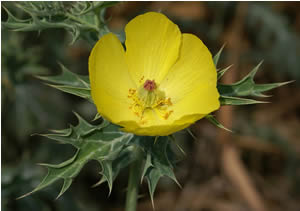Argemone - Prickly Poppy Argemone mexicana
- Common Names
- Argemone - Prickly Poppy , Mexican Poppy, bluestem
- Botanical Name
- Argemone mexicana
- Syn. A. albiflora
- Family
- PAPAVERACEAE
Medicinal Uses & Benefits of Argemone - Prickly Poppy
![]() How to Use|
Side Effects |
Plant & Garden|
How to Use|
Side Effects |
Plant & Garden|
- Properties: * Analgesic * Psychedelic
How to Use: Argemone - Prickly Poppy
This plant is very popular among those seeking a "legal high" and the mildly narcotic seeds are often mixed with tobacco or other herbs in smoking mixtures. However, most content themselves to growing the plant for its attractive flowers in native habitat gardens. Like other members of the poppy family, the prickly poppy has a long history as a traditional medicine.
“ The use of the oil of the seeds, the leaves, and the petals of this species has been quite prominent among native peoples of all tropical countries where the plant grows. Among the ancient Greeks the juice was supposed curative of cataract. In Mexico the latex juice of the plant was mixed with water for skin diseases, and the flowers used for chest complaints and as a narcotic. As a whole the plant has been conceded to be anodyne, detersive, resolutive, hpnotic, diuretic, diaphoretic, ophthalmic, and a hydragogue cathartic, appearing to unite the properties of Opium, Gamboge,and Celedine. ” Millspaugh, Charles F. "American Medicinal Plants" (1882) 20[20-2]
Preparation Methods & Dosage :The seeds are smoked, the seed oil is used in topical applications, the whole fresh plant can be made into a tincture
Argemone - Prickly Poppy Side Effects: A. mexicana seeds contain 22�36% of a pale yellow non-edible oil, called argemone oil or katkar oil, which contains the toxic alkaloids sanguinarine and dihydrosanguinarine.
Plant Description
- Plant Class: Annual weedy herb
- Flowers/Fruit/Seeds:Large yellow, or rarely white flowers. A related species, rose or spiny prickly poppy (Argemone sanguinea), has white, lavender, or purple flowers.
- Parts used: Seeds, leaves, flowers
- Leaves & Stem:Erect branching stem, prickly bristled and furnished with a yellow, milky juice. Leaves are broadly lanceolate, spiny toothed, and blotched or striped with white along the principle veins.
- Flowering Season: April to July
- Distribution: Native to tropical and subtropical America, this desert flower has become scattered as far north as Virginia, where it has escaped cultivation and grows in waste places
- Millspaugh, Charles F. "American Medicinal Plants" (1882) 44[12-2]
- Plants.usda.gov
- Singh, S.; Singh, T. D.; Singh, V. P.; Pandey, V. B. (February 2010). "Quaternary Alkaloids of Argemone mexicana". Pharmaceutical Biology 48 (2): 158�160. PMID 20645832.











